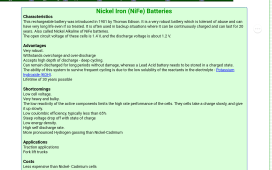electrocuted
New Member
- Joined
- Nov 9, 2021
- Messages
- 3
I am disappointed with the state of the solar industry.
It should have gone without saying right from the start that solar installations ought to have an attached battery bank, otherwise power at night is coming from what is usually a fossil fuel powered grid. There's nothing green about that. And yet this technology has been a long time coming and still, several years after buying a nickel iron battery bank I cannot find any equipment which will actually work with it.
When I found out that home owners with solar panels were also subject to blackouts in daylight hours I was gobsmacked. It is hard to imagine what these electrical engineers were thinking rolling out a system which could not be disconnected from the grid when the technology for doing so is essentially a simple switch. Now I have read about grid tie hybrid inverters which will still leave users without power in spite of full sun and a battery bank. It' just laughable that anyone could think this is acceptable, and the excuses have nothing to do with technical limitations or physics. Solar power should not be this complicated, and twenty years into the 21st century reliable uninterruptible free power is something we should all take for granted.
I have a mountain of burnt out or otherwise malfunctioning solar related electronic equipment and have taken a great many batteries to the scrapper.
I have joined this forum to share what I have learned and learn from what others have shared.
Working with solar has always been about workarounds and so I will head over to the danger zone to elaborate on the issues of nickel iron with off the shelf inverters and solar controllers.
It should have gone without saying right from the start that solar installations ought to have an attached battery bank, otherwise power at night is coming from what is usually a fossil fuel powered grid. There's nothing green about that. And yet this technology has been a long time coming and still, several years after buying a nickel iron battery bank I cannot find any equipment which will actually work with it.
When I found out that home owners with solar panels were also subject to blackouts in daylight hours I was gobsmacked. It is hard to imagine what these electrical engineers were thinking rolling out a system which could not be disconnected from the grid when the technology for doing so is essentially a simple switch. Now I have read about grid tie hybrid inverters which will still leave users without power in spite of full sun and a battery bank. It' just laughable that anyone could think this is acceptable, and the excuses have nothing to do with technical limitations or physics. Solar power should not be this complicated, and twenty years into the 21st century reliable uninterruptible free power is something we should all take for granted.
I have a mountain of burnt out or otherwise malfunctioning solar related electronic equipment and have taken a great many batteries to the scrapper.
I have joined this forum to share what I have learned and learn from what others have shared.
Working with solar has always been about workarounds and so I will head over to the danger zone to elaborate on the issues of nickel iron with off the shelf inverters and solar controllers.



